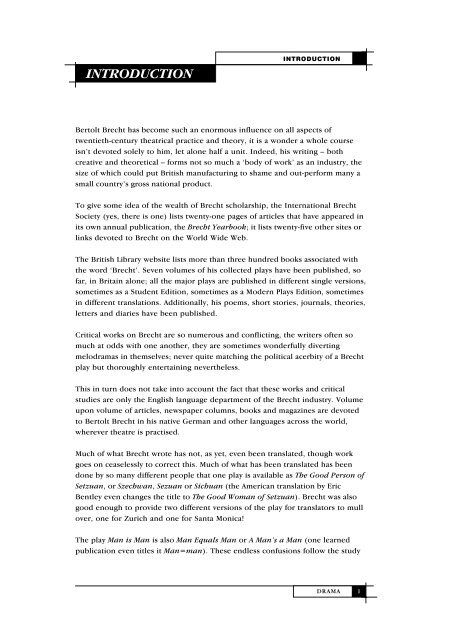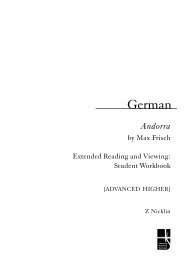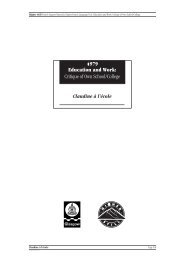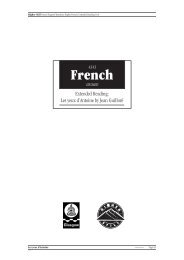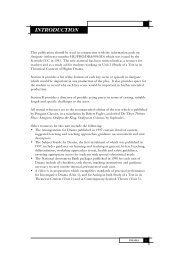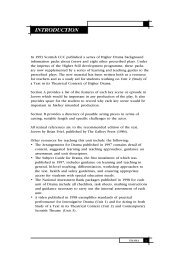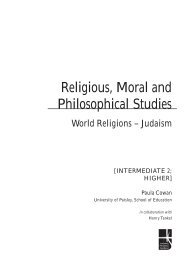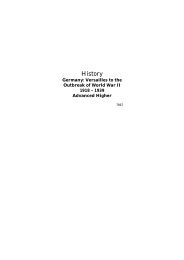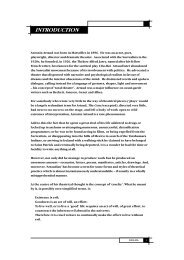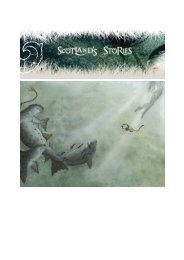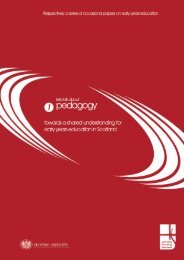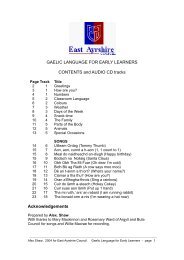Bertolt Brecht - Education Scotland
Bertolt Brecht - Education Scotland
Bertolt Brecht - Education Scotland
Create successful ePaper yourself
Turn your PDF publications into a flip-book with our unique Google optimized e-Paper software.
INTRODUCTION<br />
INTRODUCTION<br />
<strong>Bertolt</strong> <strong>Brecht</strong> has become such an enormous influence on all aspects of<br />
twentieth-century theatrical practice and theory, it is a wonder a whole course<br />
isn’t devoted solely to him, let alone half a unit. Indeed, his writing – both<br />
creative and theoretical – forms not so much a ‘body of work’ as an industry, the<br />
size of which could put British manufacturing to shame and out-perform many a<br />
small country’s gross national product.<br />
To give some idea of the wealth of <strong>Brecht</strong> scholarship, the International <strong>Brecht</strong><br />
Society (yes, there is one) lists twenty-one pages of articles that have appeared in<br />
its own annual publication, the <strong>Brecht</strong> Yearbook; it lists twenty-five other sites or<br />
links devoted to <strong>Brecht</strong> on the World Wide Web.<br />
The British Library website lists more than three hundred books associated with<br />
the word ‘<strong>Brecht</strong>’. Seven volumes of his collected plays have been published, so<br />
far, in Britain alone; all the major plays are published in different single versions,<br />
sometimes as a Student Edition, sometimes as a Modern Plays Edition, sometimes<br />
in different translations. Additionally, his poems, short stories, journals, theories,<br />
letters and diaries have been published.<br />
Critical works on <strong>Brecht</strong> are so numerous and conflicting, the writers often so<br />
much at odds with one another, they are sometimes wonderfully diverting<br />
melodramas in themselves; never quite matching the political acerbity of a <strong>Brecht</strong><br />
play but thoroughly entertaining nevertheless.<br />
This in turn does not take into account the fact that these works and critical<br />
studies are only the English language department of the <strong>Brecht</strong> industry. Volume<br />
upon volume of articles, newspaper columns, books and magazines are devoted<br />
to <strong>Bertolt</strong> <strong>Brecht</strong> in his native German and other languages across the world,<br />
wherever theatre is practised.<br />
Much of what <strong>Brecht</strong> wrote has not, as yet, even been translated, though work<br />
goes on ceaselessly to correct this. Much of what has been translated has been<br />
done by so many different people that one play is available as The Good Person of<br />
Setzuan, or Szechwan, Sezuan or Sichuan (the American translation by Eric<br />
Bentley even changes the title to The Good Woman of Setzuan). <strong>Brecht</strong> was also<br />
good enough to provide two different versions of the play for translators to mull<br />
over, one for Zurich and one for Santa Monica!<br />
The play Man is Man is also Man Equals Man or A Man’s a Man (one learned<br />
publication even titles it Man=man). These endless confusions follow the study<br />
DRAMA 1
2<br />
INTRODUCTION<br />
of <strong>Brecht</strong> around like a team of FBI agents and I have tried to take this into<br />
account when compiling this bibliography.<br />
For ease, I have tended to focus primarily on the translations of John Willett and/<br />
or Ralph Manheim who publish largely through Methuen in the United Kingdom.<br />
Some <strong>Brecht</strong> fans will prefer the Eric Bentley translations but these are published<br />
generally in the USA by the Grove Press and consequently are not as readily<br />
available. Other translations do appear in this bibliography, where and when I<br />
have considered them beneficial. As for spellings, where a writer makes reference<br />
to a play, the writer’s spelling has been used (Bentley : Setzuan; Boa : Sezuan;<br />
Hofman : Sichuan; Willett : Szechwan, etc.).<br />
Due to the enormous number of books written on the subject, there has been an<br />
urgent and genuine need for the trimming and paring down of a bibliography<br />
such as this. Unit 2: Twentieth-Century Theatre: Theories of Performance (AH) is<br />
a 40-hour course within which teachers and students will have to look at two<br />
practitioners. It is perfectly conceivable, therefore, that teachers will be looking<br />
at the need for resources to suit a 20-hour teaching and learning pack for half of<br />
the whole unit.<br />
In a bid to solve this problem, I have identified what I consider to be the Top<br />
Ten titles – critical texts from which all the suggested course content is<br />
accessible, save for actual play texts themselves.<br />
What follows this section is a selection of <strong>Brecht</strong>’s work in translation. Plays,<br />
poems and theoretical writings are included but there has been no attempt to<br />
provide details of all the work in translation. Plays have not been identified in<br />
The Top Ten due to the overwhelming number of critical works.<br />
Plays, along with other of <strong>Brecht</strong>’s own creative output, form a separate choice<br />
for students studying Unit 2. Unit 3: Special Study gives the student the option of<br />
looking at The Good Woman of Setzuan, though any of <strong>Brecht</strong>’s plays may be used<br />
for practical exploration in Unit 2. I felt this was all the more reason for keeping<br />
plays in a separate section of the bibliography.<br />
The World Wide Web is also a resource which cannot be ignored today. All the<br />
usual warnings about its unreliability, the cost of calls and connection are, of<br />
course, pertinent. However, for all the rubbish that you will dig up, there are<br />
also little nuggets with much that is relevant and interesting and demanding<br />
placed on various websites all over the world and I have included those that I<br />
think would aid teachers and students alike.<br />
Music played a vital role in <strong>Brecht</strong>’s work, and the two CDs mentioned at the tail<br />
end of this section are merely an example of those easily available. For further<br />
DRAMA
INTRODUCTION<br />
information on CDs and any form of <strong>Brecht</strong> literature and memorabilia, contact:<br />
brecht shop<br />
Obstmarkt 11<br />
86152 Augsburg<br />
Germany<br />
Tel/fax: 08 21 39 1 36<br />
The Dreigroschenheft magazine, also based in Augsburg, is another fund of<br />
information about books and productions but much of the information is given<br />
in German. The website has almost no information in English – see<br />
http://www.dreigroschenheft.de<br />
Finally, the last section of this bibliography is an annotated list, in alphabetical<br />
order, of other texts that offer a variety of perspectives on the work of <strong>Bertolt</strong><br />
<strong>Brecht</strong> and that would benefit from a reading, whether in depth or by dipping<br />
into.<br />
I have, of course, been guided in my selections by the demands of Unit 2:<br />
Twentieth-Century Theatre: Theories of Performance (AH) as outlined in the<br />
Arrangements for Drama. No bibliography of this nature can be exhaustive and<br />
can only emphasise the preferences of the compiler. I hold my hands up to this.<br />
DRAMA 3
4<br />
DRAMA
SECTION 1<br />
THE TOP TEN<br />
Most departments, I am sure, will have little money to spare. Should a<br />
department need to focus its spending gradually in the first few years on useful,<br />
important and key texts, the following would be a highly recommended place to<br />
start.<br />
<strong>Brecht</strong>, <strong>Bertolt</strong>, <strong>Brecht</strong> on Theatre: The Development of an Aesthetic, trans.<br />
J. Willett, London: Methuen, 1964<br />
One of the two most important books for any student of <strong>Brecht</strong>. It pushes<br />
Willett’s highest entry, The Theatre of <strong>Bertolt</strong> <strong>Brecht</strong>, into second place because<br />
it is <strong>Brecht</strong>’s own work.<br />
Willett has been the foremost <strong>Brecht</strong> scholar in the West over the years since<br />
<strong>Brecht</strong> burst onto the Western theatrical world in the 1950s. Willett’s<br />
translations and critical work helped to spark the explosion of interest in<br />
<strong>Brecht</strong> in the English speaking world.<br />
The book contains a first rate collection of <strong>Brecht</strong>’s writing. It is not<br />
exhaustive, and does not claim to be. The writings of <strong>Brecht</strong>, as already<br />
mentioned, are an industry in themselves, such was his prolific output: much<br />
of what he wrote has not, as yet, been translated into English, more than half<br />
a century on!<br />
So, although this book consists merely of the English language highlights, it is<br />
an extraordinarily valuable resource. Care should be taken with much of it.<br />
<strong>Brecht</strong> was a gifted dramatist and director, of that there seems little doubt.<br />
But he was also a poet and theoretician; a lover of Elizabethan and ancient<br />
Greek theatre; of bawdy songs, boxing, cabaret acts and Charlie Chaplin.<br />
Despite his genius, he could be both verbose and mischievous.<br />
Some of the more important essays include:<br />
• ‘The Modern Theatre is the Epic Theatre’;<br />
• ‘On Gestic Music’;<br />
• ‘The Street Scene’;<br />
• ‘Short Description of a New Technique of Acting which Produces an<br />
Alienation Effect’;<br />
• ‘A Short Organum for the Theatre’;<br />
• ‘Stage Design for the Epic Theatre’;<br />
• ‘Study of the First Scene of Shakespeare’s Coriolanus’;<br />
• ‘Appendices to the Short Organum’.<br />
DRAMA 5
6<br />
THE TOP TEN<br />
‘Interview with an Exile’ will also give a clue as to why <strong>Brecht</strong> had so much<br />
time for Charlie Chaplin and what he interpreted as the distancing effect of<br />
Chaplin’s acting style.<br />
The book contains a generous and helpful collection of illustrations: Caspar<br />
Neher design drawings; action photographs from various productions which<br />
reveal aspects of staging (pre- and post-Epic) – from Baal, through the<br />
Lehrstücke, to Galileo and beyond; extracts from model books, and influences<br />
on <strong>Brecht</strong> (a painting by Brueghel; a production by Piscator, etc.).<br />
As the title of the book suggests, <strong>Brecht</strong>’s theory and practice underwent a<br />
significant development between his productions of Baal and The Caucasian<br />
Chalk Circle. Here, that development is traced in his own (translated) words.<br />
Willett, John, The Theatre of <strong>Bertolt</strong> <strong>Brecht</strong>: A study from eight aspects,<br />
London: Methuen, rev. 1977<br />
The second of the two most important books for students of <strong>Brecht</strong>.<br />
Willett’s seminal work contains just about everything you need to know about<br />
<strong>Brecht</strong>: his life, his influences, his art, his theories, his politics.<br />
There is also an ‘analysis’ (less an analysis and more a plot outline) of forty<br />
plays from Baal to Turandot, necessarily brief, but which contain production<br />
details such as first production dates, and names of collaborators, designers<br />
and musicians.<br />
This is a book to read at length. All other books on <strong>Brecht</strong> must use this as a<br />
yardstick.<br />
Eddershaw, Margaret, Performing <strong>Brecht</strong>: forty years of British<br />
performances, London: Routledge, 1996<br />
An absolute gem of a book for drama and theatre students.<br />
If Epic Theatre is as much about attitude and commitment as it is about acting<br />
style, design and production technique, then this book marries the disparate<br />
areas that make up <strong>Brecht</strong> the man and <strong>Brecht</strong> the cultural institution.<br />
Eddershaw is careful to see <strong>Brecht</strong> as a theatre practitioner above all else. Her<br />
opening section deals with the differences and similarities between what both<br />
Stanislavski and <strong>Brecht</strong> achieved and desired. It is a subject to which she has<br />
returned in this book from an earlier essay, ‘Acting methods: <strong>Brecht</strong> and<br />
Stanislavski’, found in Bartram and Waine (see page 10).<br />
DRAMA
THE TOP TEN<br />
It is an important distinction, one that troubles many students (as well as<br />
actors and directors!). In many ways, what these two were after was not so very<br />
different; in others, they were poles apart. Eddershaw picks her way through<br />
this minefield adroitly and lucidly.<br />
From here, the book illustrates the work of <strong>Brecht</strong> and <strong>Brecht</strong>ian work in<br />
Britain. Marvellous case studies from the very early, and often misjudged,<br />
years (Joan Littlewood’s Theatre Workshop’s Mother Courage and The Royal<br />
Court’s The Good Woman of Setzuan, both from 1956) are followed by a<br />
mixture of more and less successful ones.<br />
The Scots actor Bill Paterson supplies a great deal of mileage for an<br />
investigation of acting in work by <strong>Brecht</strong>. This can be found in Eddershaw’s<br />
discussion of the National Theatre’s 1982 production of Schweyk in the Second<br />
World War (the fourth section of the book, ‘Performing ‘Classical’ <strong>Brecht</strong>:<br />
Making the Strange Familiar’).<br />
Three lengthy sections follow, looking at the Santa Monica version of The<br />
Good Person of Sichuan as directed by Deborah Warner at the National in 1989<br />
(for this translation by M Hofmann, see page 16); Philip Prowse’s 1990 Mother<br />
Courage at The Citizens, and a Di Trevis production of The Resistible Rise of<br />
Arturo Ui, at the National again, in 1991.<br />
Eddershaw is careful to use these three productions to balance the ‘hit-andmiss’<br />
affair of performing <strong>Brecht</strong> today. She sees Warner’s Sichuan as<br />
sentimental and non-political; Prowse’s Courage as designer-led (no surprises<br />
there), and the Trevis Ui as a success.<br />
Throughout, the book concentrates on the realisation of <strong>Brecht</strong>ian theory as<br />
practice, and as such, it gives vital clues and information to actors, designers<br />
and directors of <strong>Brecht</strong>.<br />
Willett, John, <strong>Brecht</strong> in Context: Comparative Approaches, London:<br />
Methuen, 1984<br />
No apologies for more Willett. This is another important book.<br />
The chapter on the influence of Kipling (pp44–58) is very interesting. The<br />
mere fact that there is a connection between the two, given their political<br />
persuasions, is worth noting. Willett draws on <strong>Brecht</strong>’s humanism – not done<br />
often enough – and his approach to using language, being an ‘un-literary’<br />
writer, and on his preference for actions rather than emotions.<br />
DRAMA 7
8<br />
THE TOP TEN<br />
<strong>Brecht</strong>, Willett argues, is primarily an anti-Expressionist (pp73–86). These<br />
pages look at <strong>Brecht</strong>’s links with cabaret and the sexual urgings found in<br />
Wedekind, Expressionism’s influence on <strong>Brecht</strong> and <strong>Brecht</strong>’s distance from<br />
this movement.<br />
The discussion of <strong>Brecht</strong> and Piscator (pp87–106) is valuable for its<br />
delineation of their agreements and disagreements. It also gives further<br />
evidence – if it be needed – of the collaborative nature of this radical form of<br />
theatre, with writers working together on plays, revisions, translations and<br />
adaptations. The documentary style of presentation, epic, montage, use of<br />
film, non-Western techniques and the influence of <strong>Brecht</strong>’s Moscow trip on<br />
acting techniques are all to be found in this section of the book.<br />
Light is thrown on <strong>Brecht</strong>’s obsession with crime novels and cinema (pp107–<br />
128) and its link with Arturo Ui; and on <strong>Brecht</strong>’s attitude to filming and his<br />
work on Pabst’s film of The Threepenny Opera (1931) and the semidocumentary<br />
Kuhle Wampe (1932).<br />
Chapter 8 deals with the visual arts: montage; collaborations with George<br />
Grosz and Piscator (on The Good Soldier Svejk), and Caspar Neher.<br />
Music is examined in Chapter 9 – its gestation in his own poetry and on to his<br />
love of ballads and cabaret; through to his collaborations with Weill, Eisler<br />
and Dessau (among others), and his interest in new musical movements.<br />
‘Two political excursions: b: <strong>Brecht</strong>, Alienation and Karl Marx’ (pp218–221)<br />
should be positively the last word on the translation of the troublesome<br />
<strong>Brecht</strong>ian term Verfremdung. It should provide everybody with the strongest<br />
reasons never to use the term ‘alienation’ again when discussing the work of<br />
<strong>Brecht</strong>. My own term of choice is ‘distancing’, though others will prefer one<br />
of the variety on offer, such as ‘estrangement’or ‘de-familiarisation’.<br />
Finally, and crucially, the closing chapter’s ‘after-notes’ are Willett’s notes on<br />
some of the productions he has seen over the years: The Threepenny Opera<br />
(Prague 1945); Mother Courage and Her Children (Munich 1949); The<br />
Caucasian Chalk Circle (Paris 1955); The Life of Galileo (East Berlin 1957) and<br />
The Resistible Rise of Arturo Ui (Paris 1960). These first-hand appreciations<br />
contain marvellous insights into their direction and the use of space and<br />
theatre arts. Not to be missed.<br />
Needle, Jan, and Thomson, Peter, <strong>Brecht</strong>, Oxford: Basil Blackwell, 1981<br />
This is another extremely good book, scholarly but very accessible for<br />
Advanced Higher students.<br />
DRAMA
THE TOP TEN<br />
Needle and Thomson are clearly <strong>Brecht</strong> fans but they never fall into the trap of<br />
lauding him indiscriminately. They are careful to paint what they feel is an<br />
honest assessment of his practice and theory: the undeniably great work (The<br />
Threepenny Opera is identified as his biggest hit, though his ‘masterpieces’<br />
remain the major plays written in exile); the mainly good work, and the<br />
simply weak work (Drums in the Night is described as ‘feeble’).<br />
The book is rightly keen to dispel any lingering stereotypes about German<br />
humour, or at least <strong>Brecht</strong>’s sense of humour and his desire for fun (Spass).<br />
The section on Man Equals Man stresses the broad comedy of the play but is<br />
careful to draw the distinction between the satire of artists like Grosz and<br />
what these authors read as <strong>Brecht</strong>’s irony.<br />
The section on politics (Chapter 3) has a clarity often missing in many works<br />
and will be very useful for students who often struggle with this aspect of<br />
<strong>Brecht</strong>. It is also wonderfully critical, and sometimes damning, of other books<br />
about <strong>Brecht</strong> by writers who find his politics unpalatable. (And it contains the<br />
funniest bibliographical annotation regarding Walter Benjamin’s book on<br />
<strong>Brecht</strong>.)<br />
This section is also notable for its examination of the Lehrstücke – the Baden-<br />
Baden play, He Who Said Yes and He Who Said No, The Measures Taken and<br />
The Exception and the Rule – and The Mother. The stress throughout Needle<br />
and Thomson’s argument is that <strong>Brecht</strong> may have said he was a Marxist but he<br />
was not the sort of Marxist other Marxists recognised very clearly. This picture<br />
of the ambiguous and contradictory dramatic genius is a very compelling one.<br />
More of the overtly didactic plays are dealt with in the following chapter.<br />
Gestus, Epic, the actor–audience relationship, acting style and exercises, debts<br />
to Piscator, differences with Stanislavski and opposition to naturalism, and<br />
Verfremdungseffekte are all discussed in their practical, theatrical context in<br />
the chapter on <strong>Brecht</strong>’s theory. These are, once again, pertinent and<br />
worthwhile.<br />
A tremendous chapter then follows devoted to <strong>Brecht</strong>’s original staging of<br />
Mother Courage in Berlin in 1949, ten years after it was written in his<br />
Scandinavian exile as a warning to his new countrymen not to become<br />
embroiled with the Nazis. It illustrates graphically the direction of the<br />
production. (A whole book is devoted to this subject – see Thomson, Mother<br />
Courage and Her Children on p36.)<br />
The later plays – most notably The Caucasian Chalk Circle and The Life of<br />
Galileo – are dealt with towards the end of the book, and though placed in a<br />
section as exemplification of <strong>Brecht</strong>’s dramaturgy rather than his directorial<br />
innovations, are nonetheless pithy and substantial.<br />
DRAMA 9
10<br />
THE TOP TEN<br />
Bartram, Graham, and Waine, Anthony (eds.), <strong>Brecht</strong> in Perspective, London:<br />
Longman, 1982<br />
A collection of essays aimed at an undergraduate audience though this should<br />
not put off an Advanced Higher student with a developing understanding of,<br />
and interest in, <strong>Brecht</strong>. It is undoubtedly a first-rate buy.<br />
The second section of the book is certainly the most productive. It handles<br />
the theatrical practice from its social and artistic complexities through to<br />
looking at the comparable and diverging methods used by the century’s two<br />
foremost theatrical theorists and practitioners – <strong>Brecht</strong> and Stanislavski. This<br />
latter chapter is by Margaret Eddershaw (see page 6) and should be a key text<br />
for directing options at Advanced Higher.<br />
A succinct chapter on <strong>Brecht</strong>’s great inspiration, Piscator, follows, examining<br />
their theatrical, political and personal relationship. This leads to a super<br />
essay, ‘<strong>Brecht</strong> and Cabaret’, which is detailed, informative and revealing as<br />
regards <strong>Brecht</strong>’s debt to this form of popular entertainment: a debt which runs<br />
through the development of Gestus, Verfremdung, use of music, staging,<br />
narrative structure and anti-naturalist presentational styles.<br />
As might be expected, the first section of the book treats the social, political,<br />
historical and artistic background from which <strong>Brecht</strong> sprang. There is a very<br />
good chapter on Epic theatre and a vital essay on comedy which examines<br />
<strong>Brecht</strong>’s insistence on Spass (fun) in the theatre.<br />
The book ends with a retrospective on <strong>Brecht</strong>’s legacy, both on Germanspeaking<br />
theatre and English theatre (unfortunately it is specifically English<br />
theatre and not British theatre). Like all the texts in this Top Ten which look<br />
at <strong>Brecht</strong>’s influence on theatre today, this is particularly important when<br />
students grapple with the demands of Outcome 2: ‘Explore the influence of<br />
two leading 20th-century theatre practitioners on current theatre practice’.<br />
Sacks, Glendyr, and Thomson, Peter (eds.), The Cambridge Companion to<br />
<strong>Brecht</strong>, Cambridge: CUP, 1994<br />
This is an extremely good companion, in the Top Ten due to its breadth and<br />
contemporaneity. Part of its strength is the mixture of contributions, ranging<br />
from both the academic sector’s view and the theatre practitioner’s angle.<br />
Again, all elements of <strong>Brecht</strong>’s life and work are covered, giving insights into<br />
the plays, the practice and the politics.<br />
One of the most interesting aspects of this book is how individual plays are<br />
picked up and examined in some detail. This makes it a useful tool for<br />
students taking as broad a sweep as possible through <strong>Brecht</strong>’s practice.<br />
DRAMA
THE TOP TEN<br />
As one might expect, the book opens with a trawl through the historical,<br />
political, social, theatrical, artistic background out of which emerged <strong>Brecht</strong><br />
the dramatist, poet, novelist, director and polemicist.<br />
A series of plays then come under the microscope, followed by essays on<br />
directing, theatrical theory, collaboration and acting. The book closes with,<br />
again, a good look (for the purposes of Outcome 2) at <strong>Brecht</strong>’s legacy to<br />
theatre and how modern practitioners have been influenced by him.<br />
Peter Brooker’s chapter ‘Key words in <strong>Brecht</strong>’s theory and practice of theatre’<br />
is worth highlighting. Its glossary of key words is crystal clear and provides a<br />
good starting point for students.<br />
Another vital text for the course focusing on both practical and theoretical<br />
issues.<br />
Ewen, Frederick, <strong>Bertolt</strong> <strong>Brecht</strong>: His Life, His Art, His Times, New York:<br />
Citadel Press, Carol Publishing, reissued 1992<br />
This is a mighty tome, a biography that is sympathetic to <strong>Brecht</strong> the man, the<br />
theatre practitioner and the political thinker. There should be at least one<br />
biography in the Top Ten, and this one outshines Klaus Völker’s (see page 36)<br />
due to its depth, broad scope and understanding of how central the theatre<br />
was to <strong>Brecht</strong>.<br />
Many of this book’s critics complain that it is a little cold, a little remote; that<br />
it concentrates on the work rather than the life of the man. The same critics<br />
tend also to complain when a study ignores the work at the expense of the<br />
man.<br />
What this biography does, and at some length, is make the very crucial<br />
connection between the two. The work was the means by which <strong>Brecht</strong><br />
identified himself and sought to change the world.<br />
This is a thorough, painstaking and revealing biography. It covers everything:<br />
from his early days as a pseudo-dandified cabaret act, through the political<br />
radicalism of the Lehrstücke, to Epic and beyond; from the ravaged Europe of<br />
the post-1914–18 war, to the rise of Hitler’s Nazism in Europe, out to<br />
Hollywood and finally his triumphant return to East Berlin.<br />
Chapter VIII, ‘In Quest of Identity: The Road to the Epic Theatre’, paints a<br />
vivid picture of the cultural, political and artistic vibrancy and turbulence<br />
which marked the dying embers of Expressionism and the beginning of the<br />
‘new objectivity’ (Neue Sachlichkeit).<br />
DRAMA 11
12<br />
THE TOP TEN<br />
Ewen shows Piscator’s radical theatrical innovations in fantastic detail, and<br />
demonstrates how these were vital introductions to <strong>Brecht</strong> of new, political<br />
and entertaining techniques. This chapter illustrates how objectivity meshed<br />
with political cabaret; how agit-prop raged with delight all over Germany;<br />
what cinema and Russian theatre offered; just how widespread and important<br />
the concept of collaboration was to these artists.<br />
Here too, Ewen clearly and entertainingly describes <strong>Brecht</strong>’s first steps at<br />
coming to terms with his marriage of theatre’s possibilities to his new and<br />
growing politicisation. He goes on to discuss <strong>Brecht</strong>’s revelation that ‘William’<br />
(Shakespeare) was also, to <strong>Brecht</strong>’s way of thinking, an ‘epic’ theatre<br />
practitioner.<br />
Other chapters are equally readable, packed with insights and pertinent to<br />
students of Drama and Theatre. Chapter XI, ‘The Recovery of Identity: The<br />
Epic Theatre’, contains lucid explanations and exemplifications of the acting<br />
technique associated with the Grundgestus and Gestus; the concept of<br />
Verfremdung; the actor audience relationship <strong>Brecht</strong> sought, etc., etc. The<br />
following chapter deals with the Lehrstücke. One can dip into any chapter and<br />
find essential information. The whole book is likewise valuable. This is a firstrate<br />
biography precisely because it makes a big issue out of both <strong>Brecht</strong>’s<br />
theory and his practice.<br />
McDonald, Jan, and Schumacher, Claude (eds.), The Citizens’ Theatre<br />
Season, Glasgow 1990, Glasgow: Theatre Studies Publications, The<br />
University, 1991<br />
It is important to try to maintain a Scottish angle on the course and this book<br />
provides, at least, a token towards this end.<br />
As its title suggests, it is a review of the work of one of <strong>Scotland</strong>’s most famous<br />
producing theatres over the course of the year when Glasgow had ownership<br />
of the title European City of Culture.<br />
It is, naturally, a very good resource in its own right as a survey of the work of<br />
one contemporary Scottish theatre company. Work by Pirandello, Ibanez,<br />
Dumas, Shaw, Goldoni, Rowe and, of course, <strong>Brecht</strong> is dealt with in a<br />
generally formulaic way.<br />
The formula gives the reader a synopsis, the play’s background, details of its<br />
performance, an interview with either a director, writer or actress (in the case<br />
of <strong>Brecht</strong>’s Mother Courage and Her Children, the interview is with Glenda<br />
Jackson who played the lead role), and a series of newspaper reviews of the<br />
production. It is worth noting from Jackson’s interviews that, although<br />
politically aligned with <strong>Brecht</strong>, she is influenced as an actress by both <strong>Brecht</strong><br />
and Stanislavski in her creation of the role of Mother Courage.<br />
DRAMA
THE TOP TEN<br />
Jackson’s usual honesty is a delight and offers the reader a sharply focused<br />
analysis of how she approached the role of one of <strong>Brecht</strong>’s most famous<br />
female characters.<br />
Braun, Edward, The Director and the Stage: From Naturalism to Grotowski,<br />
London: Methuen, 1982<br />
Like the previous entry, this is not specifically a text about <strong>Brecht</strong> alone but<br />
one that should prove invaluable to students of the Advanced Higher Drama<br />
course.<br />
Braun offers a broad, outstanding overview of the rise to prominence of the<br />
director since the late nineteenth century.<br />
As the nearest thing you will find to a course reader, it will introduce students<br />
to the work of Meiningen, Antoine, the Symbolists, Jarry, Stanislavski, Gordon<br />
Craig, Reinhardt, Meyerhold, Piscator, <strong>Brecht</strong>, Artaud and Grotowski.<br />
If you have not already decided which two twentieth-century theatre<br />
practitioners to study, this is the best introduction you can hope for. It does<br />
not deal specifically with Copeau, Brook or Boal, though all three of these<br />
have a great deal of mileage in The Director and the Stage – Copeau through<br />
Antoine; Brook through both Artaud and Grotowski, and Boal through <strong>Brecht</strong>.<br />
An indispensable introduction to <strong>Brecht</strong> and others.<br />
DRAMA 13
14<br />
DRAMA
SECTION 2<br />
WORKS BY BERTOLT BRECHT<br />
Methuen publish most of the work. The plays appear in several volumes as<br />
<strong>Brecht</strong>: Collected Plays, with more than twenty different translators, all edited by<br />
John Willett.<br />
• Vol. 1 (Baal, Drums in the Night, In the Jungle of the Cities, The Life of Edward<br />
II of England, A Respectable Wedding, The Beggar or the Dead Dog, Driving Out<br />
a Devil, Lux in Tenebris, The Catch), 1994.<br />
• Vol. 2 (Man Equals Man, The Elephant Calf, The Threepenny Opera, The Rise<br />
and Fall of the City of Mahagonny, The Seven Deadly Sins of the Bourgeoisie),<br />
1994.<br />
• Vol. 3 (Saint Joan of the Stockyards, The Mother, Lindbergh’s Flight, The Baden-<br />
Baden Lesson on Consent, He Said Yes/He Said No, The Decision, The Exception<br />
and the Rule, The Horatians and The Curiatians), 1997.<br />
• Vol. 4 (Round Heads and Pointed Heads, Dansen, How Much is your Iron?<br />
Trial of Lucullus, Señora Carrar’s Rifles, Fear and Misery of the Third Reich),<br />
1998.<br />
• Vol. 5 (The Life of Galileo, Mother Courage and Her Children), 1995.<br />
• Vol. 6 (The Good Person of Szechwan, The Resistible Rise of Arturo Ui, Mr<br />
Puntila and His Man Matti),1994.<br />
• Vol. 7 (The Visions of Simone Machard, Schweyk in the Second World War, The<br />
Caucasian Chalk Circle, The Duchess of Malfi), 1994.<br />
Volume 8 is not yet in print and Methuen have not yet scheduled its publication.<br />
When published, it is likely to contain the following plays: The Days of the<br />
Commune; Turandot, Report from Herrnburg; Downfall of the Egoist Johann<br />
Fatzer; The Life of Confucius; The Breadshop; The Salzburg Dance of Death.<br />
There is also a series of single plays issued as ‘Modern Plays Editions’ and<br />
another series issued as ‘Methuen Student Editions’. These vary in content.<br />
For instance, the Modern Plays edition of Mother Courage and Her Children<br />
(1980) is the same translation as the Student Edition (1983) but it has extremely<br />
useful ‘Notes and Variants’, including the text from the Mother Courage Model<br />
book, which the Student Edition does not carry. The Student Edition, however,<br />
has invaluable notes and commentary for students on meaning, characters, plot,<br />
etc., which do not appear in the Modern Plays edition.<br />
DRAMA 15
16<br />
WORKS BY BERTOLT BRECHT<br />
The other Methuen Student Editions are:<br />
The Caucasian Chalk Circle, Methuen Student Edition, trans. J & T Stern<br />
with W H Auden, with commentary and notes by Hugh Rorrison, London:<br />
Methuen, 1984<br />
This has an excellent series of photographs from <strong>Brecht</strong>’s Berliner Ensemble<br />
production, designed by Karl von Appen. The introductory notes and<br />
commentary are superb.<br />
The Life of Galileo, Methuen Student Edition, trans. J Willett, with notes and<br />
commentary by Hugh Rorrison, London: Methuen, 1986<br />
Another excellent edition.<br />
The many Methuen Modern Plays editions are all edited by John Willett and<br />
Ralph Manheim:<br />
The Threepenny Opera, trans. R Manheim and J Willett, 1979<br />
Excellent notes and texts, including one by Kurt Weill, a public letter<br />
responding to requests for his theoretical views.<br />
The Good Person of Szechwan, trans. J Willett, 1985<br />
Another good edition, which also contains the variant Santa Monica version<br />
and notes on the Zurich production.<br />
The Resistible Rise of Arturo Ui, trans. R Manheim, 1981<br />
Fear and Misery of the Third Reich, trans. J Willett, 1983<br />
The Caucasian Chalk Circle, trans. J & T Stern with W H Auden, 1963<br />
For alternatives, you might want to look at the following:<br />
The Good Person of Sichuan, trans. M Hofmann, London: Methuen, 1989<br />
Hofmann’s translation for the National Theatre in 1989 is based on the Santa<br />
Monica version of the play (the original version is from a Zurich production).<br />
It is shorter than the original, substitutes opium for tobacco and the<br />
translator’s Preface makes some pithy observations on <strong>Brecht</strong>’s use of<br />
language.<br />
Mother Courage and Her Children, adapted David Hare, London: Methuen,<br />
1995<br />
David Hare’s adaptation was used for Diana Rigg’s performance at the National<br />
Theatre in 1995.<br />
DRAMA
WORKS BY BERTOLT BRECHT<br />
The current Arrangements for Drama state that the required reading for Unit 3:<br />
Special Study is the translation by Eric Bentley. The latest edition of this is:<br />
The Good Woman of Setzuan, trans. E Bentley, Minneapolis: University of<br />
Minnesota Press, 1999<br />
Apart from the plays, <strong>Brecht</strong> wrote a great deal of other work. The following can<br />
also be obtained from Methuen.<br />
• Poems 1913–1956, J Willett and R Manheim eds., with the co-operation of E<br />
Fried, 1979<br />
• Poems and Songs from the Plays, J Willett trans. and ed., 1990<br />
• Bad Time for Poetry, J Willett ed., 1995<br />
• Collected Short Stories, J Willett and R Manheim eds., Y Kapp, H Rorrison, A<br />
Tatlow trans., 1999<br />
• <strong>Brecht</strong> on Film and Radio, Marc Silberman trans. and ed., 2000<br />
• <strong>Brecht</strong> Journals 1934–1955, H Rorrison trans., J Willett ed., 1993<br />
Libris, London publish War Primer (1997), another volume of poetry. It is edited<br />
by John Willett.<br />
DRAMA 17
18<br />
DRAMA
SECTION 3<br />
THE WORLD WIDE WEB<br />
One of the dangers of the World Wide Web is that anybody can say whatever they<br />
please about anything at all. It is an unregulated mass of opinion, some<br />
wonderfully academic and scholarly, some woefully shoddy and infantile.<br />
Websites have a habit of changing addresses, changing names, changing content,<br />
or disappearing completely. This is the nature of the Internet; this bibliography<br />
offers some sites as examples of what existed at the time of going to print.<br />
United States, Canadian and Australian universities all love sharing information or<br />
blowing their own trumpets, depending on your point of view. British academia<br />
maintains an eerie silence, as if to broadcast their ideas is somehow to devalue<br />
them.<br />
Much of what exists is not linked to any academic institution. This need not<br />
necessarily prove a danger, though usually is. Dive in and take a swim around.<br />
There is a great deal of waste product but there is also a great deal to admire and<br />
enjoy.<br />
http://polyglot.1ss.wisc.edu/german/brecht/main.html<br />
Where better to start a research exercise on the Web than here, the Homepage of<br />
the International <strong>Brecht</strong> Society.<br />
It is a non-profit, educational organisation founded in 1970 and aims to promote<br />
the work, practice and theory of <strong>Brecht</strong>. The IBS is a service for scholars, critics,<br />
students and anybody interested in theatre around the world to share ideas and<br />
opinions. It is maintained by the University of Wisconsin-Madison in the USA.<br />
There is a huge amount accessible on the site without having to join the Society,<br />
though one can get even more by joining for a small annual subscription (in<br />
1999 for students this was $20 or DM 30, in the region of £10–£12).<br />
The IBS publishes two journals (free to members), both devoted to the work of<br />
<strong>Brecht</strong>. Communications is published every six months, while the <strong>Brecht</strong><br />
Yearbook is, of course, published annually. The quality of the articles found in<br />
these publications is first class. The <strong>Brecht</strong> Yearbook 25 (for the year 2000) is to<br />
be devoted to Helene Weigel, this year being the centenary celebration of her<br />
birth.<br />
DRAMA 19
20<br />
THE WORLD WIDE WEB<br />
The <strong>Brecht</strong> Yearbooks are available without subscribing to the society. As an<br />
example, the <strong>Brecht</strong> Yearbook 24 is edited by Marc Silberman, and was published<br />
in April 1999. It can be purchased through:<br />
University of Wisconsin Press<br />
c/o European University Press Group Ltd<br />
3 Henrietta Street<br />
Covent Garden<br />
London WC2E 8LU<br />
Tel: 0171 240 0856<br />
The IBS website also contains information on productions, conferences, books<br />
due out, reviews of books, news, exhibitions, recordings, a chronology of<br />
<strong>Brecht</strong>’s life, a history of the Berliner Ensemble and four pages of links to other<br />
websites (e.g. the Kurt Weill Foundation, the Lion Feuchtwanger Memorial<br />
Library, etc.). The <strong>Brecht</strong> Centenary in 1998 saw an explosion of sites dedicated<br />
to him.<br />
Far and away the best <strong>Brecht</strong> website around.<br />
http://www.kwf.org/<br />
The Kurt Weill Foundation website. Dedicated to one of <strong>Brecht</strong>’s most famous<br />
collaborators, this site is a must-see. It is geared up for Weill’s centenary in 2000.<br />
www.usc.edu/isd/locations/ssh/special/fml/<strong>Brecht</strong>/<br />
An exhibition website titled ‘<strong>Bertolt</strong> <strong>Brecht</strong> turns 100’ by the Feuchtwanger<br />
Librarian at the University of Southern California.<br />
As an American exhibition, it obviously celebrates <strong>Brecht</strong>’s time in the USA before<br />
any other period in his life. Lion Feuchtwanger was another playwright with<br />
whom <strong>Brecht</strong> collaborated (the 1942 production of The Visions of Simone<br />
Machard). Feuchtwanger and <strong>Brecht</strong> were two of the many European artists who<br />
sat out the 1939–45 war in America. A fine online exhibition.<br />
www.fas.harvard.edu/~art/jungle2.html<br />
A very good interview with the director Robert Woodruff on his 1998 production<br />
of In the Jungle of the Cities.<br />
www.versuche.org<br />
The Homepage of the Versuche Ensemble, a little known theatre company in the<br />
USA.<br />
Of interest here is ‘The <strong>Brecht</strong> Centennial: The New York International Fringe<br />
Festival 1998’, in which seven of <strong>Brecht</strong>’s plays were produced. The Versuche<br />
DRAMA
Ensemble produced both Drums in the Night and Caucasian Chalk Circle for the<br />
festival, and their site contains a fascinating director’s logbook of notes on the<br />
company’s rehearsals. The company also provides newspaper reviews and<br />
photographs for design ideas.<br />
http://dept.english.upenn.edu/~afilreis/50s/brecht-review.html<br />
A page from a University of Pennsylvania professor’s website.<br />
This holds a great riposte from the Green Left Weekly (#77, March 1995) to John<br />
Fuegi’s attempted butchery of <strong>Brecht</strong>’s reputation (see the reference to John<br />
Fuegi’s book on page 29).<br />
http://mobydicks.com/lecture/<strong>Brecht</strong>hall/messages/41.html<br />
This is a discussion list where people interested in <strong>Brecht</strong> can post questions or<br />
answers, and share ideas. Many students post questions about issues that are<br />
troubling them for essays/assignments and can receive help or advice from all<br />
over the world.<br />
http://www.geocities.com/Paris/2427/index.html<br />
The site of the <strong>Bertolt</strong> <strong>Brecht</strong> Forum.<br />
THE WORLD WIDE WEB<br />
On this site you will find news, a celebration of Helene Weigel’s Centenary, the<br />
World Weill Day, biographies and chronologies of Neher, Eisler, Dessau and<br />
others – rather good ones, too.<br />
This site also contains the FBI files on <strong>Bertolt</strong> <strong>Brecht</strong> – all 369 pages, including<br />
passages censored with thick black lines! Absolutely fascinating but perhaps only<br />
for die-hard aficionados.<br />
(Caution: there is another site – http://www.brechtforum.org/ – titled ‘The<br />
<strong>Brecht</strong> Forum’ which is merely a part of the New York Marxist School’s website.<br />
This is a school that advocates social change through the arts and really has<br />
nothing more to do with <strong>Brecht</strong> other than using his name for an arena of<br />
discussion. Do not confuse this with the above.)<br />
http://research.haifa.ac.il/~theatre/brecht.html<br />
The University of Haifa in Israel has some production stills from its production of<br />
Fear and Misery of the Third Reich and some excellent links to other sites. These<br />
include sites with biographies, facts, archives, and more on specific texts or<br />
productions such as The Threepenny Opera, Galileo, and The Rise and Fall of the<br />
City of Mahagonny (which includes a great sketch by Neher for Act 2 scene 2).<br />
http://www..mcm.edu/academic/galileo/galileo.html<br />
McMurry University’s site that contains brief director’s notes on a University<br />
production of The Life of Galileo.<br />
DRAMA 21
22<br />
THE WORLD WIDE WEB<br />
http://www.banffcentre.ab.ca/Theatre/<br />
The Homepage of the Banff Centre for the Arts in Canada. Go to ‘search’ and<br />
type ‘brecht’, or ‘weill’, etc., and there are extracts from critical studies and<br />
histories. For example, the site has taken an extract from Douglas Jannan’s Kurt<br />
Weill: An Illustrated Biography, a great still from Threepenny Opera in 1928 and a<br />
contemporary review from The Times (naming <strong>Brecht</strong> as ‘Kurt’, curiously).<br />
http://www.goethe.de/eindex.htm<br />
The Homepage of the Goethe-Institut. Goethe-Instituts exist to promote and to<br />
foster mutual understanding through the awareness and appreciation of German<br />
culture, thought and achievement.<br />
Goethe-Instituts all over the world created websites to celebrate <strong>Brecht</strong>’s<br />
centenary in 1998. Ninety-six Goethe-Instituts currently have websites. Few of the<br />
<strong>Brecht</strong> centenary exhibitions still exist; the sites change their pages to move on<br />
to more pressing business – look out for new exhibitions at the sites (Kurt Weill<br />
and Helene Weigel both celebrate their centenaries in 2000).<br />
The Goethe-Institut of Hong Kong (at http://www.goethe.de/os/hon/enbb100/<br />
enbbex2.htm) seems to have kept its online <strong>Brecht</strong> centenary exhibition and<br />
texts, certainly up to early 2000. (The São Paolo Goethe-Institut has done the<br />
same, though in Portuguese.)<br />
The Goethe-Institut of London (http://www.goethe.de/gr/lon/enindex.htm)<br />
currently has an exhibition by Exeter College Foundation Arts students who have<br />
responded in fine arts to plays by <strong>Brecht</strong>. It is advisable to visit from time to time<br />
to see what is new. You can also post enquiries.<br />
Glasgow has its own Goethe-Institut at: http://www.goethe.de/gr/gla<br />
http://www.pads.ahds.ac.uk/pads.html<br />
The Performing Arts Data Service (PADS) at Glasgow University is a vast,<br />
staggering directory of theatre resources with links to just about everywhere of<br />
interest.<br />
The PADS Theatre Directory can take you to http://www.siue.edu/PROJECT2000<br />
in which you can see scenic, costume and lighting designs from productions<br />
across the world.<br />
There are photographs from an Argentinian The Life of Galileo from 1995–6,<br />
Happy End from the University of Michigan, Mother Courage from a 1985<br />
production at the University of Denver and The Threepenny Opera in two forms:<br />
one from the University of Cincinnati and one from Brandeis University (these<br />
photographs can even be blown up for better resolution).<br />
DRAMA
Recordings<br />
THE WORLD WIDE WEB<br />
Many recordings exist of Weill/<strong>Brecht</strong> songs, mostly in Germany or the USA. A<br />
good place to find what recent work has been released is the International <strong>Brecht</strong><br />
Society website. However, more than enough of a flavour of the work can be<br />
obtained from the following CDs.<br />
Die Dreigroschenoper: Berlin 1930 (Teldec Classics International, Warners<br />
Communication Company, 1990)<br />
This is a single CD that contains original work from the Kurt Weill/<strong>Bertolt</strong><br />
<strong>Brecht</strong> collaboration.<br />
Highlights from The Threepenny Opera (Die Dreigroschenoper) running to<br />
thirteen tracks open the CD, and there are also two songs from The Rise and<br />
Fall of the City of Mahagonny among other work by other artists from this<br />
collection of Berlin recordings. An outstanding resource and insight into the<br />
times.<br />
Lost in the Stars: The Music of Kurt Weill (A&M Records, 1985)<br />
A collection celebrating Weill’s work recorded by more contemporary artists,<br />
including Lou Reed, Marianne Faithfull and Tom Waits.<br />
One of the Weill/<strong>Brecht</strong> recordings included on this CD is a surprisingly good<br />
version of ‘The Ballad of Mac the Knife’ from The Threepenny Opera by, of all<br />
people, Sting.<br />
<strong>Brecht</strong> songs – audiotape A319/16Z, Milton Keynes: Open University<br />
<strong>Education</strong>al Enterprises, 1992<br />
From the Level 3 course, A319 Literature in the Modern World, containing a<br />
variety of songs and discussions of songs and their composition by <strong>Brecht</strong> and<br />
Weill.<br />
<strong>Brecht</strong> on Stage – videotape A319/16V, Milton Keynes: Open University<br />
<strong>Education</strong>al Enterprises, 1992<br />
A twenty-four minute video on which Professor Hans Mayer discusses how<br />
Mother Courage was staged. It also has footage and interviews, including one<br />
with Helene Weigel. The Open University changes its courses fairly regularly,<br />
so this video may not be shown too many more times; catch it if you can. Far<br />
too expensive to buy at £145.<br />
DRAMA 23
24<br />
DRAMA
SECTION 4<br />
CRITICAL STUDIES<br />
Bate, J, and Jackson, R (eds.), Shakespeare: An Illustrated Stage History,<br />
Oxford: Oxford University Press, 1996<br />
In Inga-Stina Ewbanks’s ‘European Cross-Currents’ there is a short section on<br />
<strong>Brecht</strong>’s Shakespearean influences and his struggle to adapt and stage<br />
Coriolanus (and a good photograph from the Berliner Ensemble’s 1964<br />
production Coriolan – Fig 59, p136).<br />
Benjamin, W, Understanding <strong>Brecht</strong>, London: Verso, 1973<br />
This is very definitely a book for connoisseurs. The opening chapters, ‘What is<br />
Epic Theatre?’ are certainly worth a read but perhaps only after having been<br />
introduced to this concept in other, less florid, books. The closing chapter,<br />
‘Conversations with <strong>Brecht</strong>’, has to be read to be believed.<br />
Bessell, R (et al), Literature and History: A319 (Block 08), Milton Keynes:<br />
Open University Press, 1991<br />
An extremely good chapter on <strong>Brecht</strong> and Mother Courage that poses many<br />
questions about the role of the artist in society and the importance of history<br />
and politics in literature and drama.<br />
Boa, E, The Sexual Circus: Wedekind’s theatre of subversion, Oxford: Basil<br />
Blackwell, 1987<br />
Of particular use is Chapter 9 ‘Wedekind and Modern Theatre’ (pp212–227),<br />
in which Boa draws parallels, comparisons and contrasts between the work of<br />
Wedekind and <strong>Brecht</strong> (Caucasian Chalk Circle, The Good Woman of Sezuan,<br />
Mann ist Mann, Mother Courage). It focuses also on <strong>Brecht</strong>’s theatrical effects.<br />
Worth a read, though it is designed for more advanced, undergraduate study.<br />
Boal, A, Theatre of the Oppressed, trans. Charles A & Maria-Odilia Leal<br />
McBride, London: Pluto Press, 1979<br />
If ever there was a theatrical practitioner of whom you could say, ‘this could<br />
be the son of <strong>Brecht</strong>’, then Augusto Boal is your man.<br />
Boal, a Brazilian who worked originally in Latin America and now is based in<br />
both Rio de Janeiro and Paris, has taken theatre as a tool for social change to<br />
areas <strong>Brecht</strong> could only have dreamed about. He takes <strong>Brecht</strong>’s political<br />
commitment, theory and practice further and, one could argue, in more<br />
radical directions than one suspects <strong>Brecht</strong> might have done due to his nonreliance<br />
on literary forms and the theatrical conventions of actor, script and<br />
venue.<br />
DRAMA 25
26<br />
CRITICAL STUDIES<br />
Boal’s work with the working classes is designed to revolutionise society by<br />
giving them the means to overthrow their oppressors. Perhaps his most radical<br />
theatrical move has been in the area of actor-audience relationship: for Boal,<br />
the desire is for everybody to become ‘spect-actors’.<br />
Arguably the most important book published in political theatre theory and<br />
practice since <strong>Brecht</strong>.<br />
(A new, revised edition of this book is due for publication in June 2000, also<br />
published by Pluto Press.)<br />
Boal, A, Games for Actors and Non-Actors, trans. Jackson, A, London:<br />
Routledge, 1992<br />
A brilliant book with practical games and theoretical justifications for actors,<br />
both professional and amateur.<br />
All the work is geared to follow Boal’s fundamental premise, that theatre is a<br />
functional, social tool, able to liberate the minds and bodies of the people<br />
from oppression.<br />
Boal, A, The Rainbow of Desire: The Boal Method of Theatre and Therapy,<br />
trans. Jackson, A, London: Routledge, 1995<br />
Another book of exercises, explanations and justifications for the way Boal<br />
uses theatre as a social device. Boal’s work is more starkly aimed at the sociobehavioural<br />
end of the artistic process in this book, though whether it was<br />
anything other than this is open to debate.<br />
Bradbury, M, and McFarlane, J, Modernism: 1890–1930, Harmondsworth:<br />
Penguin, 1976<br />
With claims rife for <strong>Brecht</strong>’s proto-postmodernism, it may be interesting to<br />
discover just where the original claims for his being a modernist came from.<br />
Martin Esslin’s essay, ‘Modernist Drama: Wedekind to <strong>Brecht</strong>’, will put this<br />
into sharp focus.<br />
Brooker, Peter (ed.), <strong>Bertolt</strong> <strong>Brecht</strong>: Dialectics, Poetry, Politics, London and<br />
New York: Croom Helm, 1988<br />
Good on the relationship between politics and theory and practice.<br />
Bull, J, New British Political Dramatists, London: Macmillan, 1984<br />
Another in the very good Macmillan Modern Dramatists series. Brenton, Hare,<br />
Griffiths and Edgar come in for the most acute analysis, but there is much<br />
more than that in this very good survey of the topic, that serves to illustrate<br />
how the British used practitioners like <strong>Brecht</strong> in their own work.<br />
DRAMA
CRITICAL STUDIES<br />
Calandra, D, German Dramatists, London: Macmillan, 1983<br />
Contains a survey of modern dramatic writing in German, such as Heiner<br />
Muller, Peter Handke, Franz Xaver Kroetz and Botho Strauss.<br />
It is interesting in its own right, of course, but the more so due to the insights<br />
it gives into how these dramatists have been influenced by <strong>Brecht</strong>. They have<br />
both taken him further and reacted against his theory and practice – in some<br />
cases (e.g. Kroetz) they have done both of these things.<br />
There are interesting theoretical comparisons (Heiner Muller’s ‘learning play’<br />
Mauser (1970) and The Measure’s Taken, one of <strong>Brecht</strong>’s most celebrated<br />
Lehrstücke) and practical influences on staging and design (Thomas Brasch’s<br />
Rotter, A German Fairy Tale and <strong>Brecht</strong>’s own production of Man is Man).<br />
Cooper, S, and Mackey, S, Theatre Studies: An Approach for Advanced Level,<br />
Cheltenham: Stanley Thornes, 1996<br />
A very useful textbook indeed, examining theatrical meaning, the process of<br />
presentation, historical context, textual analysis and contemporary productions.<br />
Part 4 is of special interest to students of <strong>Brecht</strong>, containing a chronology of<br />
his life, a biography, an excellent survey of the plays through their<br />
performance and <strong>Brecht</strong>’s theoretical developments (section 4.4.3 ‘Theory and<br />
Practice’, pp292–309), influences and followers, and a reasonably interesting<br />
essay question with a guideline to its answering.<br />
This final page of the <strong>Brecht</strong> chapter is only ‘reasonable’ because the<br />
‘advanced’ of the title is the A-Level in England. The textbook has been<br />
written for English qualifications, rather than Scottish awards, and is therefore<br />
very specific. Other than this aspect, though, it is still a very good buy.<br />
Counsell, Colin, Signs of Performance: An Introduction to Twentieth-Century<br />
Theatre, London: Routledge, 1996<br />
Chapter 3, ‘<strong>Brecht</strong> and Epic Theatre’, places <strong>Brecht</strong> in a modernist role and<br />
gives a good survey of his influences and work. (The book also has chapters<br />
on Stanislavski and Brook.)<br />
Craig, S (ed.), Dreams and Deconstructions: alternative theatre in Britain,<br />
Ambergate: Amber Lane Press, 1980<br />
A thoroughly entertaining and well-illustrated book on the frantic theatrical<br />
activity of 70s Britain. From the influences of <strong>Brecht</strong> on political theatre to the<br />
fringe, community theatre, theatre-in-education, writers and performance art.<br />
DRAMA 27
28<br />
CRITICAL STUDIES<br />
Delgado, M M, and Heritage, P (eds.), In Contact with the Gods?: Directors<br />
talk Theatre, Manchester: Manchester University Press, 1996<br />
A series of interesting essays from around the world. From <strong>Brecht</strong> admirers<br />
like Augusto Boal to others less enamoured like Jorge Lavelli. Lavelli is a Parisbased<br />
Argentinian who does not so much dislike the work or ideas of <strong>Brecht</strong><br />
as the rigid icon he became; he also disapproves of what he perceives to be<br />
the shackling of artistic freedom endemic in the <strong>Brecht</strong> heritage. The Italian<br />
director Giorgio Strehler also writes a great deal of sense about <strong>Brecht</strong>’s<br />
political persuasion.<br />
Demetz, P (ed.), <strong>Brecht</strong>: A collection of critical essays, Englewood Cliffs,<br />
USA: Prentice-Hall, 1962<br />
A difficult book to purchase today, but so old that it is usually available in<br />
libraries.<br />
A selection of essays on theory, several plays (e.g. Caucasian Chalk Circle, The<br />
Life of Galileo, Mother Courage and Her Children, Saint Joan of the<br />
Stockyards), music and language.<br />
However, the highlight of the book has to be an abridged, hilarious transcript<br />
of ‘The Testimony of Berthold <strong>Brecht</strong>: Hearings of the House Committee on<br />
Un-American Activities’ given on 30 October 1947, in which <strong>Brecht</strong> runs rings<br />
round his interrogators from what has become known as the ‘McCarthy Witchhunt’.<br />
DiCenzo, M, The Politics of Alternative Theatre in Britain, 1968–1990: the<br />
case of 7:84 (<strong>Scotland</strong>), Cambridge: Cambridge University Press, 1996<br />
There is a considerable section on McGrath’s The Cheviot, The Stag and The<br />
Black, Black Oil, in the chapter ‘From theory to practice: the plays’ (pp151–<br />
219). This also contains a lucid explanation of the debt McGrath owes to<br />
<strong>Brecht</strong> and Epic theatre.<br />
A super book which might also be considered a good buy for the purposes of<br />
the Higher Unit 3: Contemporary Scottish Theatre.<br />
Docherty, Brian (ed.), European Drama, London: Macmillan, 1994<br />
The chapter by Ronald Spiers, ‘<strong>Brecht</strong>’s Theory and Practice’ (pp26–41), is<br />
interesting on <strong>Brecht</strong>’s use of masks and the role of emotion and empathy in<br />
<strong>Brecht</strong>’s theatre.<br />
Esslin, M, <strong>Brecht</strong>: A Choice of Evils, London: Heinemann, 1959<br />
Some people swear by this book, others at it. Like many critics who have<br />
problems with <strong>Brecht</strong>’s politics (Brustein, Spiers, Hayman, etc.), there is a<br />
patronising air about this study, implying that <strong>Brecht</strong> was a great artist<br />
somewhat by accident; that his art ‘transcended’ his politics. It did nothing of<br />
DRAMA
CRITICAL STUDIES<br />
the kind, of course, but Esslin and others work tremendously hard trying to<br />
convince us otherwise.<br />
Fuegi, J, The Life and Lies of <strong>Bertolt</strong> <strong>Brecht</strong>, London: HarperCollins, 1994<br />
Fuegi has many books about <strong>Brecht</strong> on the market (The Essential <strong>Brecht</strong>,<br />
<strong>Bertolt</strong> <strong>Brecht</strong>: Chaos, According to Plan), but this is the one that really stirred<br />
up the pot.<br />
It is the most controversial book written on <strong>Brecht</strong> in years, possibly ever. The<br />
storm of accusations and subsequent counter-accusations is an epic drama in<br />
itself. Even in the Preface, Fuegi likens <strong>Brecht</strong> to Stalin and Hitler; the alleged<br />
theft of other people’s work to which he put his own name is likened to the<br />
gassing of the Jews during the Holocaust. This is clearly an important book,<br />
though its veracity is wide open to serious questioning (the <strong>Brecht</strong> Yearbook<br />
that followed its publication ran a 100-page destruction of Fuegi’s ‘evidence’<br />
and assertions).<br />
It runs to 752 pages and is therefore to be browsed lightly only: for <strong>Brecht</strong>’s<br />
joining of Group 1925 (p148); his early days in Munich and the influence of<br />
Wedekind and cabaret; his work with Piscator and for Fuegi’s opinions on<br />
<strong>Brecht</strong>’s ‘collaborations’ with writers, directors, designers and musicians.<br />
Caution must be advised when skimming this book. Fuegi has an axe to grind<br />
and he doesn’t mind who knows it.<br />
Fulbrook, M, The Fontana History of Germany: 1918–1990, The Divided<br />
Nation, London: Fontana, 1991<br />
An extremely accessible history textbook. Part One, pp17–125, is the most<br />
relevant section for the purposes of contextualising <strong>Brecht</strong>’s work.<br />
Giles, S, and Livingstone, R (eds.), <strong>Bertolt</strong> <strong>Brecht</strong>: Centenary Essays,<br />
Amsterdam: Rodopi, 1998<br />
New articles on subjects such as collaboration, Marxism, Galileo, <strong>Brecht</strong> and<br />
East German cultural policy, gestus.<br />
Goorney, H, The Theatre Workshop Story, London: Methuen, 1981<br />
This is some story to tell, as well. Joan Littlewood was a pioneering woman of<br />
the theatre who embraced <strong>Brecht</strong> in her work from an extremely early stage,<br />
playing Mother Courage herself in 1955, before the Berliner Ensemble made<br />
their extraordinary impact on the British stage the following year.<br />
Goorney, H, and MacColl, E (eds.), Agit-prop to Theatre Workshop: political<br />
playscripts 1930–50, Manchester: Manchester University Press, 1986<br />
An exciting resource, displaying the impact political theatre had in Britain<br />
while <strong>Brecht</strong> was working with similar impulses in Germany.<br />
DRAMA 29
30<br />
CRITICAL STUDIES<br />
Gray, F, John Arden, London: Macmillan, 1982<br />
As with the other books in the series (Macmillan Modern Dramatists), this is an<br />
easy-to-read guide to the works of a neglected modern playwright (though not<br />
as neglected as his wife and collaborator, Margaretta D’Arcy) and one heavily<br />
influenced by <strong>Brecht</strong> and reflective of <strong>Brecht</strong>’s practice and theories.<br />
Gray, Ronald, <strong>Brecht</strong> the Dramatist, Cambridge: Cambridge University Press,<br />
1976<br />
Lucid and politically informed analyses of playtexts.<br />
Hayman, R (ed.), The German Theatre: a symposium, London: Wolff, 1975<br />
Hayman is not always a fan of Willett’s (he calls his translations ‘approximate<br />
and inaccurate secondhand accounts’, p201!) and his own chapter in this<br />
collection (‘<strong>Brecht</strong> in the English Theatre’) carries his usual prejudices.<br />
However, he does paint a vivid picture of the theatrical experience of a<br />
Berliner Ensemble production in England. He also deals with the influence of<br />
<strong>Brecht</strong> on British political theatre (Joan Littlewood, John Arden, Edward<br />
Bond, etc.). Worth a trip to the library or an inter-library loan (the Mitchell<br />
Library, Glasgow, has a copy) to read but not to buy.<br />
Hayman, R, <strong>Bertolt</strong> <strong>Brecht</strong>: The Plays, London: Heinemann, 1984<br />
Hayman has translated the works himself which leads to some confusion,<br />
especially with titles, but this is a slim book, with short analyses of a great<br />
many of the plays. They contain some good sense but are shot through with a<br />
distrust of <strong>Brecht</strong>’s politics.<br />
Hirst, D L, Edward Bond, London: Macmillan, 1985<br />
Yet another in the Modern Dramatists series. Bond is one of the leading<br />
British political dramatists of the second half of the twentieth century and<br />
would be the first to admit an enormous debt to <strong>Brecht</strong>.<br />
Hodgson, T, Modern Drama from Ibsen to Fugard, London: Batsford, 1992<br />
‘<strong>Brecht</strong>’s Later Epic Theatre and its Impact’, pp161–171, contains a<br />
surprisingly good section on the staging of The Caucasian Chalk Circle.<br />
Hunt, A, Arden: A Study of his Plays, London: Eyre Methuen, 1974<br />
The mantle of <strong>Brecht</strong> was certainly worn by John Arden and Margaretta D’Arcy<br />
in the 1960s, using subject matter pertinent to Britain’s political system and<br />
theatrical techniques to question their audiences. The section on The Hero<br />
Rises Up (pp128–143) is very good.<br />
Innes, C, Erwin Piscator’s political theatre: the development of modern<br />
German drama, Cambridge: Cambridge University Press, 1972<br />
An excellent, detailed description of the ‘Red Revue’ (pp43–47), the form of<br />
political cabaret that utilised propaganda, newsreel, popular theatre<br />
DRAMA
CRITICAL STUDIES<br />
conventions, etc. These are densely illustrative of the techniques picked up by<br />
<strong>Brecht</strong> and used in his theatrical practice. The whole chapter, ‘Agitprop and<br />
Revue: Society’ (pp41–65) is well worth reading.<br />
Innes is also keen to stress the importance of Piscator’s influence on <strong>Brecht</strong><br />
and does so very well (pp189–200). A much neglected source on <strong>Brecht</strong>’s<br />
practice and a much neglected book, generally.<br />
Innes, C, Holy Theatre: Ritual and the Avant Garde, Cambridge: Cambridge<br />
University Press, 1981<br />
It is sometimes difficult to imagine how much stern, political theatre can share<br />
common interests and practices with wild, avant garde theatre. The reality, of<br />
course, is that ‘political’ does not necessarily equate with ‘stern’, or ‘avant<br />
garde’ with ‘wild’.<br />
Innes is a very astute critic when it comes to placing together the various<br />
strands of perceived opposites. Artaud shared with <strong>Brecht</strong> initial outrage at the<br />
same social and artistic complacencies of the period. <strong>Brecht</strong> shares a concern<br />
with the complexities of audience reception which drives some ‘avant garde’<br />
practitioners to what seem extraordinary lengths to shock. It is the same<br />
accusation sometimes levelled at political ‘realists’, as <strong>Brecht</strong> is occasionally<br />
termed.<br />
By no means an easy book due to the theoretical background being such an<br />
important aspect of work in the avant garde (and the attempt to rationalise it).<br />
This book will benefit students looking at where <strong>Brecht</strong>ian concerns with<br />
society took other practitioners of his period and our own period.<br />
Innes, C, Modern British Drama 1890–1990, Cambridge: Cambridge<br />
University Press, 1992<br />
This is a vivid survey, vast in scope, leaving very little out on the way.<br />
The whole fourth chapter (‘Social themes and realistic formulae’) is worth<br />
reading but the sub-section 4.8, ‘<strong>Brecht</strong>ian influences: Epic stagecraft and<br />
British equivalents’, is clearly the most valuable in looking at <strong>Brecht</strong>’s legacy.<br />
Innes is never overly respectful, pointing out contradictions in <strong>Brecht</strong>ian<br />
theory and practice, and placing <strong>Brecht</strong> in a theatrical tradition rather than<br />
positing him as an explosive revolutionary.<br />
The sections that follow this on Arden, Bond, Edgar, Brenton and Hare will<br />
help to chart the development of British political theatre after <strong>Brecht</strong>.<br />
DRAMA 31
32<br />
CRITICAL STUDIES<br />
Itzin, C, Stages in the Revolution: political theatre in Britain since 1968,<br />
London: Methuen, 1980<br />
A great read, written less in an academic manner and more with a journalistic<br />
clarity. The theatrical activity of the left in the ten years between 1968 and<br />
1978 is all here, bursting with <strong>Brecht</strong>ian influences.<br />
Jameson, F, <strong>Brecht</strong> and Method, London: Verso, 1998<br />
By one of the foremost writers on postmodernism and culture, Jameson’s<br />
book is a difficult read but one that, while trying to claim parts of <strong>Brecht</strong> for<br />
postmodernism, also recognises his modernist roots. (Jameson prefers the<br />
translation ‘estrangement’, rather than ‘alienation’, for Verfremdung.) Read the<br />
section on The Caucasian Chalk Circle and the positing of a theoretical<br />
reasoning for his use of pre-modernist peasantry set against the modernism of<br />
capitalists.<br />
Jones, David Richard, Great Directors at Work: Stanislavski, <strong>Brecht</strong>, Kazan,<br />
Brook, Berkeley and London: University of California Press, 1976<br />
Includes in-depth description and analysis of Mother Courage model book.<br />
Kaye, N, Postmodernism and Performance, London: Macmillan, 1994<br />
There is absolutely no mention whatsoever of <strong>Bertolt</strong> <strong>Brecht</strong> in this book. As a<br />
study of postmodernist practice, it is concerned with ‘disruption’ of the<br />
spectacle and narrative, and the challenging of hierarchies. All these concerns,<br />
of course, are very <strong>Brecht</strong>ian but due to the postmodernist perspective, room<br />
for a meta-narrative such as Marxism is forbidden. This book will provide<br />
insight into the practice of theatre that many ex-leftwing political theatre<br />
practitioners have moved into. The content and theory may differ, but some of<br />
the techniques and rationales for their use, are remarkably similar. (This book<br />
may also provide some challenging ideas for Unit 1: Devised Drama.)<br />
Kleber, P, and Visser, C (eds.), Re-interpreting <strong>Brecht</strong>: his influence on<br />
contemporary drama and film, Cambridge: Cambridge University Press,<br />
1990<br />
Another series of essays, some better than others.<br />
‘Blocking <strong>Brecht</strong>’ by Maarten Van Dijk is a superb account of the 1983 RSC<br />
production of Mother Courage and the conflict between faithfulness to, and<br />
re-interpretation of, a classic piece of drama.<br />
‘The Origins, Aims and Objectives of the Berliner Ensemble’ by Joachim<br />
Tenschent is eminently readable, short and very much to the point.<br />
Klaus Völker’s ‘Productions of <strong>Brecht</strong>’s plays on the West German Stage, 1945–<br />
1986’ takes a little time to warm up but when it does (as Volker begins to<br />
DRAMA
CRITICAL STUDIES<br />
discuss a 1979 production of Saint Joan of the Stockyards in Bochum) it<br />
illustrates graphically the nuts and bolts of some modern productions.<br />
Kleberg, L, Theatre as Action: Soviet Russian Avant-Garde Aesthetics,<br />
London: Macmillan, 1993<br />
Contains an interesting section on the influences between <strong>Brecht</strong> and<br />
Tretyakov.<br />
McGrath, J, A Good Night Out. Popular Theatre: Audience, Class and Form,<br />
2nd edn, London: Nick Hern Books, 1996<br />
The doyen of British political theatre in the 1970s, McGrath founded the<br />
theatre company 7:84 <strong>Scotland</strong> (the English 7:84 no longer exists, a victim of<br />
Thatcherite cuts in the 1980s). This is a classic manifesto, delivered originally<br />
as a series of lectures at Cambridge University (the irony is not lost on<br />
McGrath).<br />
Chapter 3, ‘Mediating Contemporary Reality’, in which McGrath pays his<br />
respects to <strong>Brecht</strong>, is particularly pertinent. McGrath’s contemporary Scottish<br />
play, The Cheviot, The Stag and The Black, Black Oil, could be an homage to<br />
Weimar Germany Red Revue cabaret.<br />
Mitchell, T, Dario Fo: People’s Court Jester, London: Methuen, rev., 1986<br />
A fabulous look at Italy’s comic genius. A theatre practitioner who not only<br />
took political theatre in different directions from <strong>Brecht</strong>, but took <strong>Brecht</strong>’s<br />
work in such different directions that <strong>Brecht</strong>’s daughter would not let him<br />
produce the re-write of Threepenny Opera that was commissioned by the<br />
Berliner Ensemble. See ‘Political Theatre on Shifting Ground 1974–1983’<br />
pp71–94.<br />
Mitter, S, Systems of Rehearsal: Stanislavski, <strong>Brecht</strong>, Grotowski and Brook,<br />
London: Routledge, 1992<br />
Chapter 2, ‘To Be and Not To Be: <strong>Bertolt</strong> <strong>Brecht</strong> and Peter Brook’, is useful<br />
mostly for the influence that <strong>Brecht</strong> has had on Peter Brook and the reaction<br />
against <strong>Brecht</strong> that Peter Brook has gone through.<br />
Rather high-brow, but worth a look, especially if combining these two<br />
practitioners on the Unit. Students might pretend to be in ‘Friends’ and go to<br />
Borders or Waterstone’s to read this chapter while drinking coffee. It will<br />
save some money.<br />
Patterson, M, German Theatre Today: post-war theatre in West and East<br />
Germany, London: Pitman, 1976<br />
Chapter 6, ‘Political Theatre in the East’, concentrates on <strong>Brecht</strong>’s work from<br />
his return to Europe in 1947. It is extremely revealing on the work of the<br />
DRAMA 33
34<br />
CRITICAL STUDIES<br />
Berliner Ensemble after <strong>Brecht</strong>’s death in 1956, and the subsequent influence<br />
he and the company had on German-speaking theatre.<br />
Patterson, M, The Revolution in German Theatre 1900–1933, London:<br />
Routledge, 1981<br />
This is wide-ranging survey of the German theatre out of which <strong>Brecht</strong> sprang.<br />
The first part of the book deals with the social, political, philosophical,<br />
scientific and theatrical background of Expressionist theatre.<br />
The second part is much more important, particularly on the ‘Red Revues’ or<br />
political cabarets of <strong>Brecht</strong>’s youth. Also of great interest is the highly useful<br />
chapter that deals largely with <strong>Brecht</strong>’s production of Man equals Man,<br />
including sections on its set design, music, acting style and photographs from<br />
the 1931 production showing actors on stilts and the use of the famous halfcurtain.<br />
Patterson, M (ed. and trans.), Georg Büchner: Complete Plays, London:<br />
Methuen, 1987<br />
Büchner’s Woyzeck is credited with having led the way for the Expressionist<br />
and Realist experiments in theatre in the early twentieth century. <strong>Brecht</strong>’s<br />
Baal owes something to the play.<br />
Reinelt, Janelle, After <strong>Brecht</strong>: British Epic Theatre, Ann Arbor: University of<br />
Michigan Press, 1994<br />
Worth consulting, the subject matter is indicated in the title.<br />
Rius, Marx for Beginners, London: Writers and Readers Ltd, 1976<br />
Part of the problem for students of <strong>Brecht</strong> is the political aspect of his work.<br />
Marxism, and even Socialism, are becoming alien concepts today, so cheap,<br />
cheerful, easy-to-read introductions to this might be helpful.<br />
One of a series of cartoon beginners’ books, this one is actually fairly useful as<br />
a beginners’ guide (much more so than the one on <strong>Brecht</strong> in the same series,<br />
see page 36). Considering just how complex the topic is, it might be worth<br />
obtaining a class copy to pass around each student in turn.<br />
Schutzman, M, and Cohen-Cruz, J, Playing Boal: Theatre, therapy, activism,<br />
London: Routledge, 1994<br />
Though a dense and difficult book, it contains an extremely good essay that<br />
explores <strong>Brecht</strong>’s concept of the Gestus. Philip Auslander’s ‘Boal, Blau, <strong>Brecht</strong>:<br />
The Body’ (pp124–133) attempts to show how Boal, influenced by <strong>Brecht</strong>,<br />
explores oppression through theatrical means. Auslander uses an example<br />
from Caucasian Chalk Circle to help him do this, and also some of Boal’s<br />
other theatrical influences, such as Grotowski and Artaud. A revealing essay.<br />
DRAMA
CRITICAL STUDIES<br />
Sebald, W G (ed.), A Radical Stage: Theatre in Germany in the 1970s and<br />
1980s, Oxford: Berg, 1988<br />
This book is as interesting for what it does not say about <strong>Brecht</strong> as it is for<br />
what it does say. It is indicative of the attempts made in Germany to get away<br />
from <strong>Brecht</strong>’s influence during a time when <strong>Brecht</strong>’s influence was so strong,<br />
particularly in Britain and throughout the rest of the Western world.<br />
Sidnel, M. J, Sources of Dramatic Theory: Volume 2: Voltaire to Hugo,<br />
Cambridge: Cambridge University Press, 1994<br />
Volume Two of what will be a super four-volume series. This is very advanced<br />
and therefore to be read in libraries and only to be dipped into. Of particular<br />
interest in this volume is the section on the effects of performance on<br />
audience behaviour.<br />
Simon, R, Introducing Marxism, London: A Communist Party Publication,<br />
1986<br />
Like the Rius beginners’ book, this is designed to give some options to<br />
teachers and students over the choice of texts concerning the political<br />
persuasion prevalent in <strong>Brecht</strong>’s work.<br />
The Communist Party of Great Britain may have been many things but they did<br />
produce extraordinarily accessible introductions to topics, and this is one of<br />
them.<br />
Spiers, R, <strong>Brecht</strong>’s Early Plays, London: Macmillan, 1982<br />
Lengthy looks at the early plays, Baal, Drums in the Night, In the Jungle of the<br />
Cities, The Life of Edward the Second of England, A Man’s a Man and operas<br />
and the Lehrstücke.<br />
Though written by one of those critics who has difficulty with the fact that<br />
<strong>Brecht</strong> is both a first-class artist and a Marxist, this is a useful companion to the<br />
early plays.<br />
Spiers, R, <strong>Bertolt</strong> <strong>Brecht</strong>, London: Macmillan, 1987<br />
Spiers is better on the analyses of the plays than he is helpful on the ‘hows’ of<br />
any one production. Nevertheless, this handy volume covers five of the later<br />
plays in some detail: Saint Joan of the Stockyards; Mother Courage and Her<br />
Children; The Life of Galileo; The Good Person of Szechwan and The Caucasian<br />
Chalk Circle. There is a useful, general chapter on <strong>Brecht</strong>’s practical approach<br />
to theatre.<br />
DRAMA 35
36<br />
CRITICAL STUDIES<br />
Stevenson, R, and Wallace, G (eds.), Scottish Theatre Since the Seventies,<br />
Edinburgh: Edinburgh University Press, 1996<br />
Olga Taxidou’s ‘Epic Theatre in <strong>Scotland</strong>’ is clearly the most obvious choice of<br />
reading from this wide-ranging book: there are other moments with<br />
interesting passages concerning <strong>Brecht</strong> in <strong>Scotland</strong>.<br />
Styan, J L, Modern Drama in Theory and Practice: Volume 3. Expressionism<br />
and Epic Theatre, Cambridge: Cambridge University Press, 1983<br />
Last of a three-part survey of modern theatre that is as lucid and engaging as<br />
the other two volumes. Highly recommended.<br />
Thomson, P (with a conclusion by Gardner, V), Mother Courage and Her<br />
Children, Cambridge: Cambridge University Press, 1997<br />
A whole study devoted to the production history of a single play. Outstanding.<br />
Thoss, M, <strong>Brecht</strong> for Beginners, London: Writers and Readers Ltd, 1994<br />
This is <strong>Brecht</strong>’s entire life and work drawn as a comic book, with text, line<br />
drawings and photographs. It is highly entertaining but the title ‘for<br />
Beginners’ is extremely misleading.<br />
Völker, K, <strong>Brecht</strong>: A Biography, trans. Nowell, J, London: Marion Boyars, 1979<br />
Charts <strong>Brecht</strong>’s early development and influences – Rimbaud, Wedekind,<br />
Shakespeare, Kipling, and others – his long association with Caspar Neher and<br />
his penchant for collaboration.<br />
A chapter on Baal (pp44–50) also looks at <strong>Brecht</strong>’s perpetual revisions of the<br />
play over the years, due mostly to the fact that it was originally written before<br />
he became a Marxist and later <strong>Brecht</strong> wanted to introduce elements of his<br />
Marxist beliefs into the play.<br />
An analysis of In The Jungle of the Cities (pp75–83) deals with <strong>Brecht</strong>’s use of<br />
Chicago as a distancing effect, to be used in later years, most particularly in<br />
Arturo Ui (the collaboration of Margarete Steffin on Ui is dealt with on p271).<br />
Volker also looks at Man is Man (pp118–124), Round Heads and Pointed<br />
Heads (pp227–229) – which Völker believes to be a much neglected parable –<br />
and the debt <strong>Brecht</strong> owed to Shakespeare’s Measure for Measure.<br />
There is a great series of twenty-four photographs of the didactic play What is<br />
the Price of Iron? that clearly emphasise its anti-naturalist staging and design,<br />
its early Epic techniques and <strong>Brecht</strong>’s collaboration with Ruth Berlau.<br />
Völker goes on to look at Saint Joan of the Stockyards (yet again set in<br />
Chicago) on pp152–159; Elisabeth Hauptmann’s collaboration, its drawing on<br />
his earlier In the Jungle of the Cities and the influence of Shakespeare on this<br />
play. Herr Puntila and his Servant Matti is considered on pp273–281.<br />
DRAMA
CRITICAL STUDIES<br />
There is also an excellent insight into <strong>Brecht</strong>’s Hollywood stay (pp282–294)<br />
during which he worked on fifty film projects, sold only one but managed to<br />
make a great deal of money from other writing and the selling of the rights to<br />
projects. Völker then focuses on <strong>Brecht</strong>’s move to New York (pp295–314), his<br />
visit to the House Committee on Un-American Activities, his return to Europe<br />
and the beginning of the Berliner Ensemble (from p335), and the central role<br />
Helene Weigel played in it.<br />
The chapter ‘My Pupils and Friends’ (pp344–350), that details the end of<br />
<strong>Brecht</strong>’s life, does not shy away from <strong>Brecht</strong>’s notorious philandering, though<br />
it is not particularly kind to Weigel, either (and nor was <strong>Brecht</strong> by the sound<br />
of it).<br />
A great read. Very compassionate, sympathetic and positive regarding <strong>Brecht</strong><br />
but its strength is its determination to be as honest about him as possible.<br />
Whitford, F (exhibition curator), and Wood, A (text editor), The Berlin of<br />
George Grosz: Drawings, Watercolours and Prints, 1912–1930, Royal<br />
Academy of Arts, London, (1977) New Haven and London: Yale University<br />
Press, 1997<br />
Grosz, though criticised for his politics by <strong>Brecht</strong>, was a friend and occasional<br />
collaborator. He designed Piscator’s The Good Soldier Schwejk in 1928 and<br />
provided some drawings for some of <strong>Brecht</strong>’s poetry.<br />
His broad caricatures are a clue to some of the more exaggerated design<br />
elements in early <strong>Brecht</strong> productions.<br />
Willett, J, Expressionism, London: Weidenfeld and Nicolson, 1970<br />
A worthy piece on contextual information.<br />
Willett, J, The New Sobriety, 1917–1933: Art and politics in the Weimar<br />
period, London: Thames and Hudson, 1978<br />
A broad overview of the artistic movements of the period. A first-rate study.<br />
Willett, J, The Weimar Years: A Culture Cut Short, London: Thames and<br />
Hudson, 1984<br />
This period is a wonderful example for anybody interested in the relationship<br />
between art and politics, society and culture. From the November Revolution<br />
of 1918, to Expressionism, Bauhaus, the New Objectivity (Neue Sachlichkeit)<br />
and, of course, <strong>Brecht</strong>. Willett provides another excellent text on the subject.<br />
Willett, J, Caspar Neher: <strong>Brecht</strong>’s Designer, London: Methuen, 1986<br />
Excellent resource, full of articles, sketches and photographs on the work of<br />
Neher, both with <strong>Brecht</strong> and with others.<br />
DRAMA 37
38<br />
CRITICAL STUDIES<br />
Willett, J, The Theatre of the Weimar Republic, New York: Holmes and Meier<br />
Publishing Inc., 1988<br />
For a change, this is not as readable as some of Willett’s other work, bogged<br />
down as it is with lists of dates and information. However, it is still a<br />
thoroughly interesting achievement. (It is due to be re-issued in 2000.)<br />
Williams, R, Drama from Ibsen to <strong>Brecht</strong>, London: Penguin, rev. 1968<br />
A classic text with a short chapter on <strong>Brecht</strong> placing him in a historical process<br />
and theatrical context.<br />
Wright, E, Postmodern <strong>Brecht</strong>: a re-presentation, London: Routledge, 1989<br />
Someone had to write this book, of course. <strong>Brecht</strong> is open to claims by<br />
postmodernists to be one of their own due, for instance, to the disruption of<br />
narrative (among other practices and beliefs) and Wright duly claims aspects of<br />
his theory and some of his early playtexts for the postmodernist cause – one<br />
might almost hear a plaintive riposte from <strong>Brecht</strong>’s graveside.<br />
DRAMA


